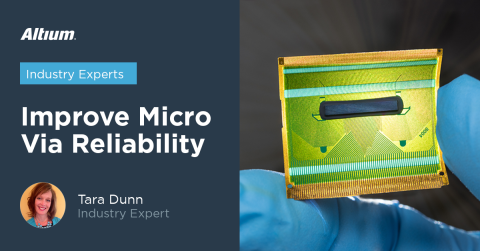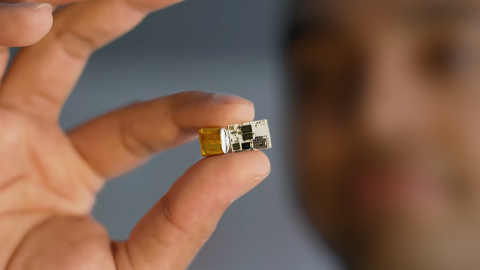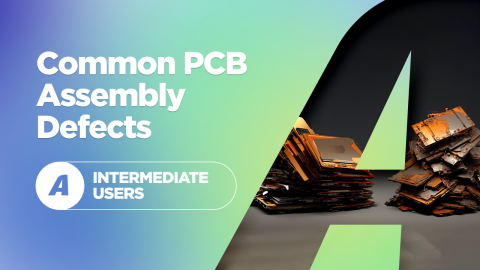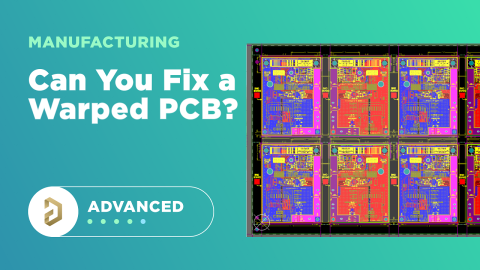How to Choose Board Plating and Thickness for Your PCB

Once your board passes through the standard PCB fabrication process, the bare copper in your PCB will be ready for the application of a surface finish. PCB plating is applied to protect any copper in your PCB that would be exposed through the solder mask, whether it’s a pad, via, or other conductive element. Designers will often default to something like tin-lead (SnPb) plating, but other plating options may be better for your board’s application.
In this article, I’ll run over the different PCB plating material options and their advantages in your PCB. There are several options to choose from, and depending on your reliability or application needs, you may need to check that your fabricator can apply the plating you need in your design. We’ll look at these options as well as a brief discussion of how plating affects losses.
Types of PCB Plating
PCB plating materials come in several varieties. I’ve compiled the popular materials designers should know and understand in the sections below. I’ve never seen a manufacturer that doesn’t offer all of these options. If your intended manufacturer doesn’t explicitly state they offer one of the options in the list below, you can always email them to get a list of their capabilities, including their PCB plating material options.
Tin-Lead (SnPb) and Immersion Tin
This PCB surface finish is probably the cheapest option, but it will not comply with RoHS due to use of lead in the plating finish. Immersion tin is a lead-free alternative that can be used in entry-level boards.
|
|
|
|
|
|
|
|
|
|
|
|
|
|
|
|
|
Hot-air Solder Leveling (HASL) and lead-free HASL
HASL was historically a very popular surface finish choice, but it is not as reliable as other plating materials. It is inexpensive and is available in a lead-free option, so it can be used as an entry-level plating option.
|
|
|
|
|
|
|
|
|
|
|
Electroless Nickel Immersion Gold (ENIG)
Given the disadvantages of SnPb and immersion tin, ENIG is now arguably the most popular surface finish in the industry. In this plating material, nickel acts as a barrier layer between copper and the thin gold surface layer where components will be soldered.
|
|
|
|
|
|
|
|
|
|
|
|
|
|
|
|
|
|
|
|
|
|
|
Organic Solderability Preservative (OSP)
This organic water-based surface finish selectively bonds to copper to provide a highly planar surface finish. As an organic material, it is sensitive to handling and contaminants, although the application process is simpler than for other PCB plating materials. It also has very low loss at high frequencies.
|
|
|
|
|
|
|
|
|
|
|
|
|
|
|
|
|
Immersion Silver
This is my PCB plating material of choice for high-frequency applications. It forms a smooth interface against bare copper, so it does not add as much conductor loss as other PCB surface finishes. The main drawback is tarnishing on bare boards, so it should be soldered and packaged ASAP after fabrication.
|
|
|
|
|
|
|
|
|
|
|
|
|
|
|
|
|
Electroless Nickel Electroless Palladium Immersion Gold (ENEPIG)
This plating material has a copper-nickel-palladium-gold layer structure that is wire-bondable directly to the plating. The final layer of gold is very thin, just as is the case in ENIG. The gold layer is soft, just as in ENIG, so excessive mechanical damage or deep scratches might expose the palladium layer.
|
|
|
|
|
|
|
|
|
|
|
|
|
|
|
|
|
Hard Gold
This plating material is essentially ENIG but with a very thick gold outer layer, thus it is among the most expensive PCB plating materials. The gold layer provides a hard surface that can be damaged, but its thickness makes it difficult to totally expose the nickel layer.
|
|
|
|
|
|
|
|
|
|
|
|
|
|
Among all of the above options, ENIG is arguably the best balance of cost durability, and range of application. For most low-frequency analog systems or digital systems that don't always run at fast edge rates (e.g., SPI or I2C), ENIG will often be the plating of choice, including in high reliability systems that need to reach IPC Class 3 compliance. It’s also suitable for pads on dense BGAs or QFN packages. Once we look at alternative plating materials shown above, we see some other applications that are more ideal: immersion silver or OSP are best for RF systems, while immersion tin is probably fine for throwaway (Class 1) products that just need lead-free compliance. In more specialized applications like very high speed digital and RF, the thickness is very important, as I’ll detail below.
How to Specify PCB Plating Material and Thickness
Typical PCB plating thickness values are somewhere around 100 micro-inches. For immersion silver and OSP, the typical thickness can be as low as approximately 10 micro-inches. Specifying the type and thickness of PCB plating is easy: you include it in your fabrication notes (see the example below). If you’re producing a prototype and the manufacturer has a standard quote form, you’ll have an opportunity to specify the plating type in their form. In these forms, they might not ask you for the thickness, so make sure you specify this if you need a specific thickness. Once you’ve specified the required plating value, it’s up to your fabricator to ensure the plating can be reliably deposited to the required thickness.

Why should the thickness of the plating material matter? There are two reasons for this. First, the IPC-2221A standard specifies a minimum plating thickness for each of the IPC product classes (see Table 4.3, you can download a copy of this standard from my site at this link). If you want your product to be compliant with any of the standard IPC product classes, then you’ll want to ensure your plating thickness meets their spec. Normally, if you specify a product class as you would typically do in your fabrication notes, then the minimum plating thickness is implied. Just make sure you don’t contradict yourself, otherwise your fabricator will email you asking about the plating note.
The other reason to worry about PCB plating thickness is the effect it has on losses. At low frequencies, you probably won’t notice any effects on frequency, so low-speed digital signals and sub-GHz radios won’t need to worry so much about PCB plating thickness. I’ve done custom printed emitters operating at 5.8 GHz WiFi with ENIG (not the best for high frequency) that swamped the receiver in our test setup, so you can even get away with most platings at these frequencies if your circuit is designed correctly.
The issue with losses arises at mmWave frequencies, like short range radar (24 GHz) and higher. At these frequencies, copper roughness becomes a very noticeable contributor to losses, especially on low-loss RF substrates like Rogers. The plating thickness will determine the amount of roughness experienced by signals as they propagate, which will manifest itself in the skin effect resistance. For some example results, look at the results from John Coonrod in this article, specifically the set of graphs showing insertion loss. As can be seen, larger amounts of rough plating can increase losses. For convenience, I’ve reproduced one graph below for microstrips.

Once you’ve determined the PCB plating you need in your design and you’re ready to specify your fabrication requirements, you can create your documentation with the easy-to-use manufacturing tools in Altium Designer®. Once your design is ready for a thorough design review and manufacturing, your team can share and collaborate in real time through the Altium 365™ platform. Design teams can use Altium 365 to share manufacturing data and fabrication requirements through a secure cloud platform.
We have only scratched the surface of what’s possible with Altium Designer on Altium 365. Start your free trial of Altium Designer + Altium 365 today.










